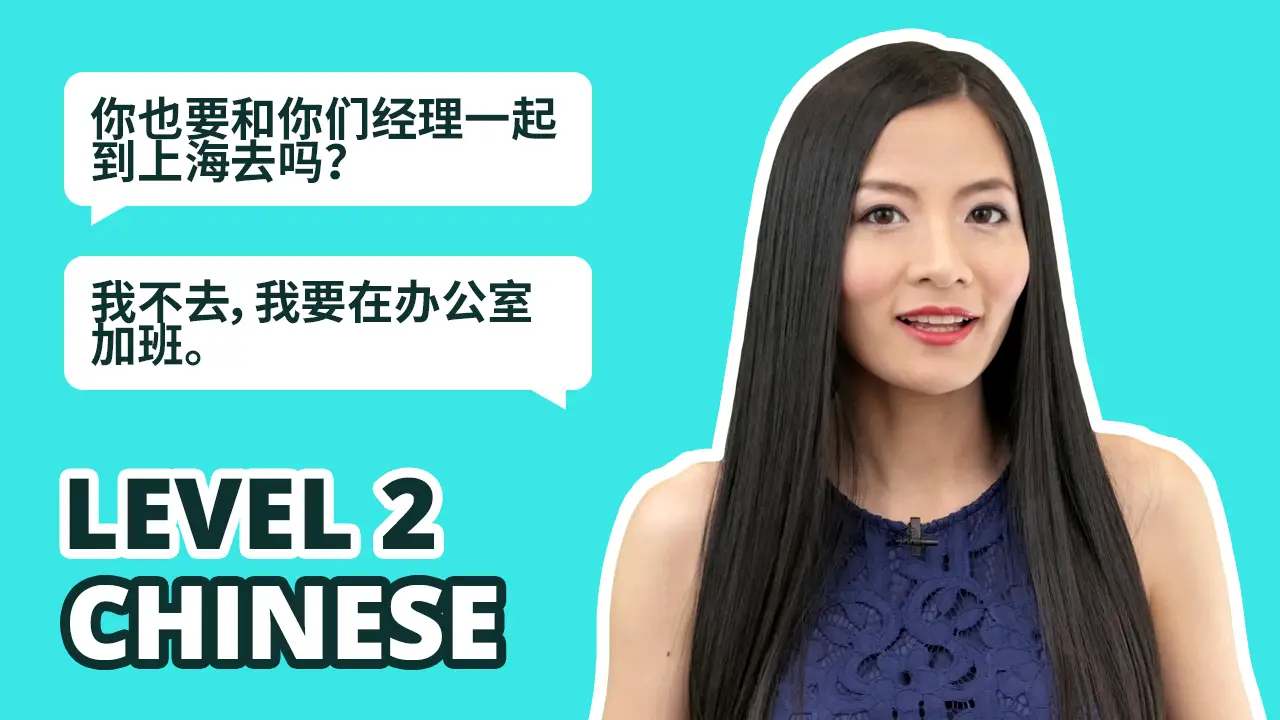Level 2 Lesson 25.1 – Her Hair Is Black
Colors in Chinese | Reduplication of Adjectives
In today's video lesson we’ll learn how to ask and describe colors in Chinese. We'll also learn about the structure Reduplication of Adjectives and learn more about Topic-Comment Sentences in Chinese.
- Colors in Chinese: White, Red and Black
- Reduplication of Adjectives
- Topic-Comment Sentences in Chinese (II) 主题评论句 (II). See also (I)
VOCABULARY
GRAMMAR
Grammar 1: Colors in Chinese · HSK 2
In today's lesson we'll start with three basic colors in Chinese: white, red and black. Each color has an adjective version and a noun version:
| Adj. | hóng 红 |
bái 白 |
hēi 黑 |
| of the color red | of the color white | of the color black | |
| Noun | hóngsè 红色 |
báisè 白色 |
hēisè 黑色 |
| the color red | the color white | the color black |
There are situations where we can use both the adjective or the noun version, while there are also situations where we can only say the one-character adjective words, or only the two-character noun words.
(1) If we’re saying phrases like red clothes, black hair, white car, meaning that the colors are used as the Attributives, we can use both the one-character Adjective version and the two-character Noun version.
For example,
- hóng yīfu / hóngsè de yīfu
红衣服 / 红色的衣服
red clothes - bái xiàofú / báisè de xiàofú
白校服 / 白色的校服
white school uniform - hēi tóufa / hēisè de tóufa
黑头发 / 黑色的头发
black hair / black hair
(2) If we want to describe and identify the color of something, we need to follow this structure:
Something + 是 + [Some Color] + 的。
And here for "some color" we can use both the one-character Adjective version and also the two-color character noun version. For example,
- tā de yǎnjing shì hēisè de
她的眼睛是黑色的。
Her eyes are (something that are of) black color. - tā de yǎnjing shì hēi de
她的眼睛是黑的。
Her eyes are (something that are of the color) black.
- zhè ge zúqiú shì báisè de
这个足球是白色的。
This soccer ball is (something that is of) white color. - zhè ge zúqiú shì bái de
这个足球是白的。
This soccer ball is (something that is of the color) white.
And to ask questions, we can say:
- nǐ de zìxíngchē shì shénme yánsè de
你的自行车是什么颜色的?
Your bicycle is what color? - nà tiáo chuán shì shénme yánsè de
那条船是什么颜色的?
That "tiao" (of) boat is what color?
(3) When the color is used as the Subject or Object of the sentence, we usually go with the noun, two-character version. For example,
- hóngsè zhēnde hěn hǎokàn
红色真的很好看。
(The) Red color (is) really good-looking. - wǒ zuì bù xǐhuan báisè
我最不喜欢白色。
I (do) not like (the) white color (the) most.
(4) When the color is used as the Predicate of the sentence to describe something, we usually go with the adjective, one-character version.
- háizi de liǎn hóng le
孩子的脸红了。
(The) kid's face (became) red. - wàimiàn tiān zhēn hēi
外面天真黑。
Outside (the) sky (is) really black(/dark).
(5) When it’s already a set word, where the color is part of the word itself, instead of an attribute to modify it, we usually just use the one-character adjective version. For example,
- bái tóufa
白头发
white(/gray) hair - hēimǐ
黑米
black rice - hóngchá
红茶
red(/black) tea - hóngduì
红队
red team
Grammar 2: Reduplication of Adjectives in Chinese · HSK 2
We have learned Reduplication of Verbs before, Adjectives can also be reduplicated. Reduplication of Adjectives are usually expressing a positive attitude on the speaker’s side, it’s usually approving or appreciative. For example,
| One-character Adjective A |
Reduplication of Adjective AA |
| hóng 红 red |
hóng hóng 红红 (approving & appreciative) red |
| cháng 长 long |
cháng cháng 长长 (approving & appreciative) long |
| gāo 高 tall |
gāo gāo 高高 (approving & appreciative) tall |
| Two-character Adjective AB |
Reduplication of Adjective AABB |
| piàoliang 漂亮 beautiful |
piàopiào liàngliàng 漂漂亮亮 (approving & appreciative) beautiful |
| jiànkāng 健康 healthy |
jiànjiàn kāngkāng 健健康康 (approving & appreciative) healthy |
| kuàilè 快乐 happy |
kuàikuài lèlè 快快乐乐 (approving & appreciative) happy |
Grammar 3: Topic-Comment Sentences in Chinese (II) · HSK 2
We have learned Topic-Comment Sentences in Chinese before. In Chinese when we want to describe a person's look, we usually put what we want to describe at the beginning of the sentence, as the Topic of the sentence, and then make the comment. For example,
| TOPIC | COMMENT | |
| māma de tóufa 妈妈的头发 mom's hair |
chángcháng de 长长的 (is) long |
。 |
| háizi de liǎn 孩子的脸 kid's face |
hěn xiǎo 很小 (is) very small |
。 |
And while the following sentences are grammatically correct in Chinese, native speakers usually don't say them:
- Māma yǒu chángcháng de tóufa.
*妈妈有长长的头发。
Mom has long-long hair. - Háizi yǒu hěn xiǎo de liǎn.
*孩子有很小的脸。
(The) kid has very small face.
1 Comment
Leave a Reply
You must be logged in to post a comment.

I have a question about the last example: “His eyes are big and his hair is black” (他的眼睛大大的,头发黑黑的)
Of course there are different ways to say this. Would it sound awkward if someone mixed the methods in the same sentence? i.e. “他的眼睛很大的,头发黑黑的”
I assume that this would sound awkward and that the methods should be consistent within a sentence, is that correct?